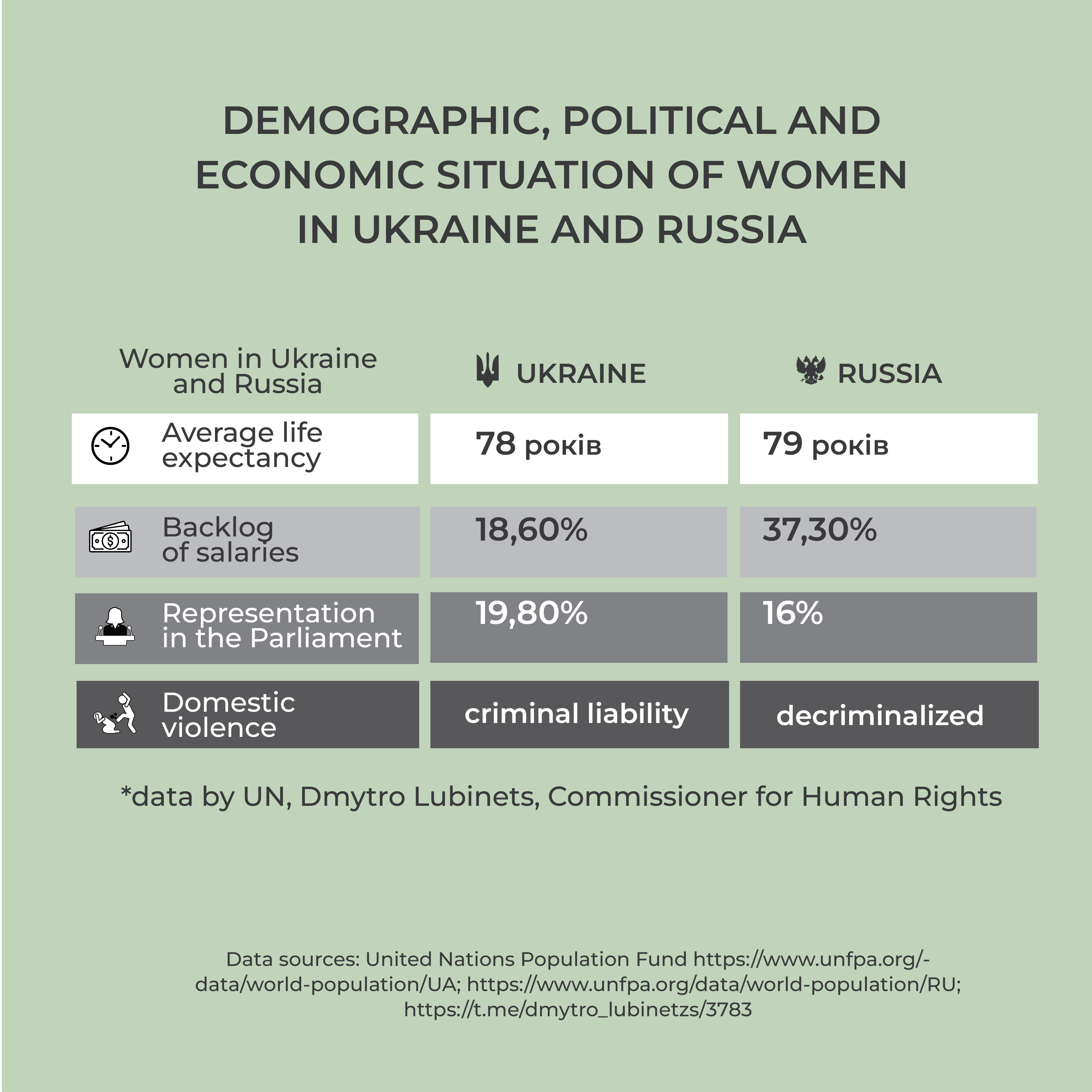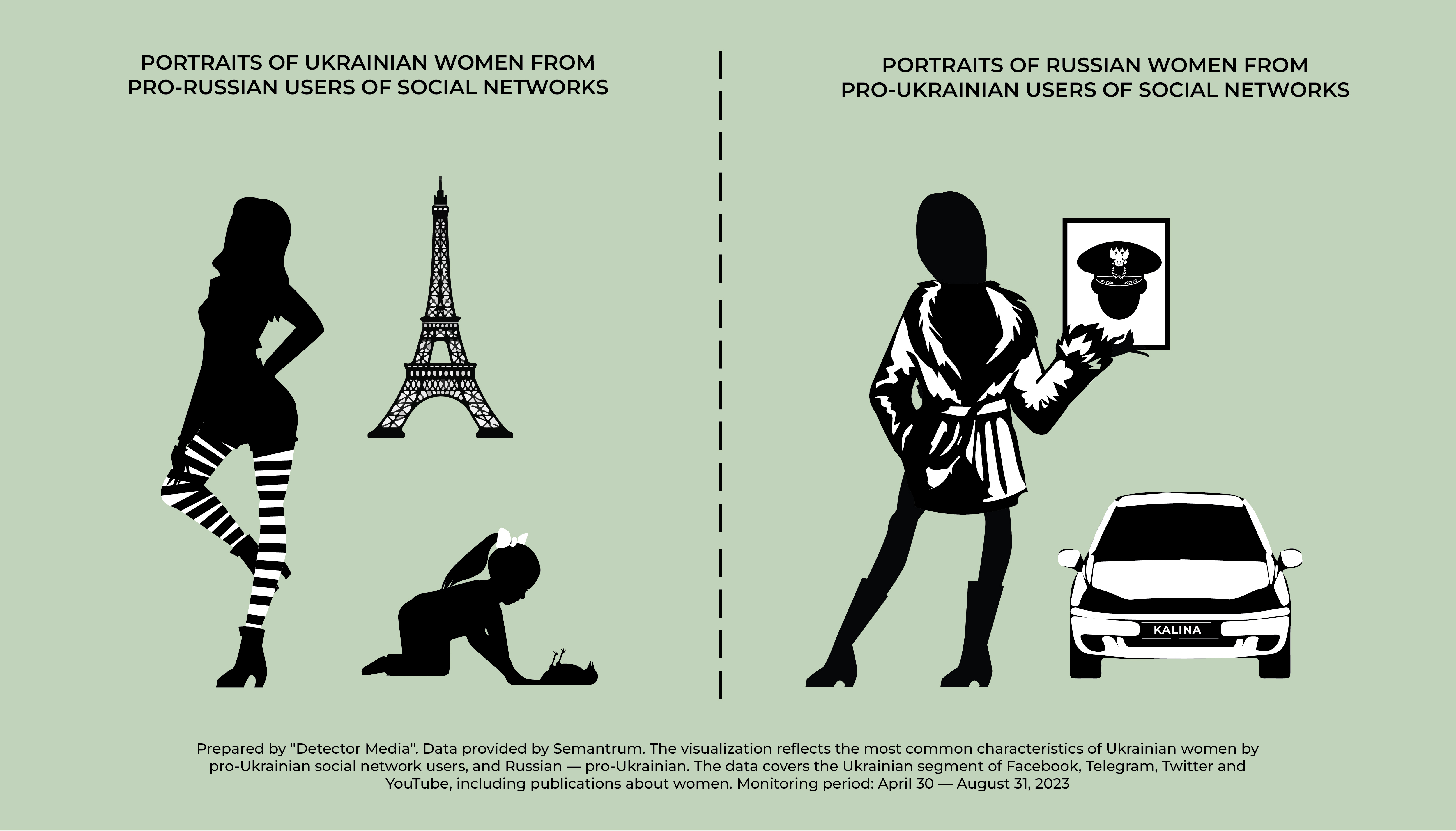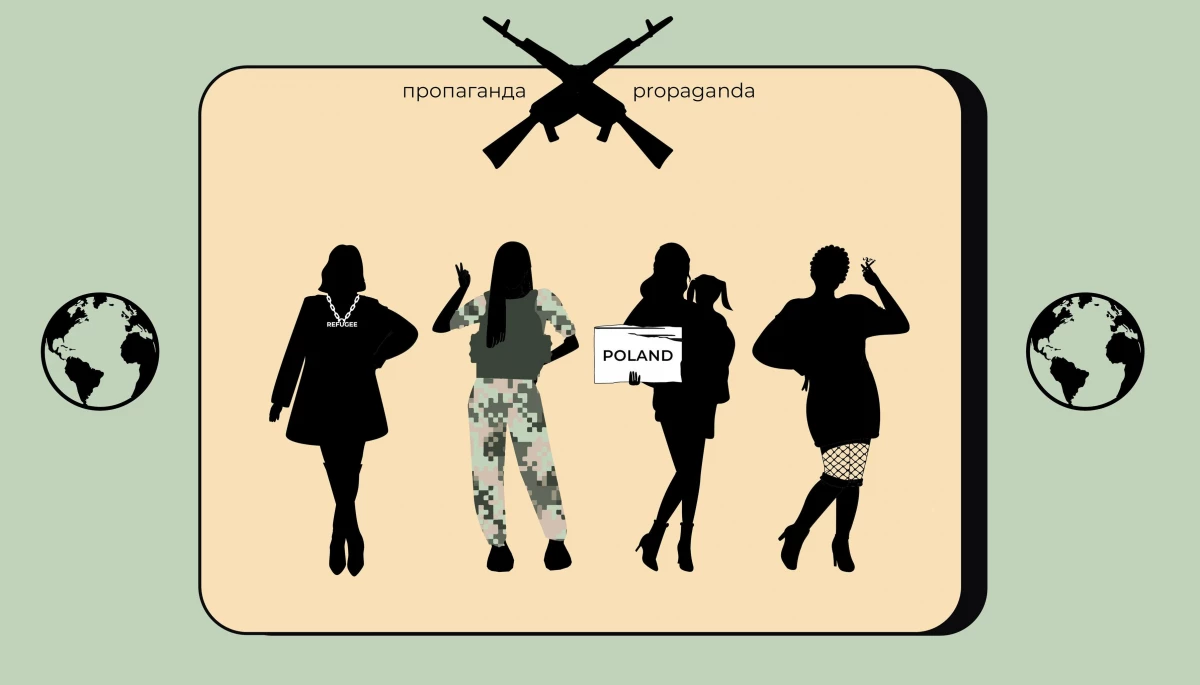






Women in armed conflicts represent one of the most vulnerable social groups. Some researchers label the Russian aggression as a war against the gender order or a genderized confrontation since Moscow is fighting for the so-called “traditional values” that champion patriarchal practices and negate gender equality. Russia is rapidly regressing into neo-traditionalism, promoting hyper-masculinity and misogyny. Hostile propaganda portrays Europe as a decadent Other, with rampant feminists, prostitutes, and the erosion of “true masculine essence.” Ukraine, according to propagandists, was once part of the glorious “Russian Gothic” but, after Europeanizing, adopted harmful practices of gender equality. Hegemonic masculinity in Russia is tied to subordinated femininity. War and aggression only intensify this trend. Propagandists often reiterate that war is no business for women, thus, the current events are a triumph of male will. In this narrative, a woman’s role is to patiently wait in the rear, mourn fallen soldiers, and give birth to new ones. Russia aims to establish Domostroy – a backward patriarchal structure with unconditional subordination to the family head – in its relations with Ukraine. Moscow expected that Kyiv would forever remain within its sphere of influence and obediently play the role of a compliant partner. However, Ukraine showed defiance, broke the vicious cycle of these toxic relations, and, according to propagandists, succumbed to “destructive Western values.” Our study delves into the ways Russian propaganda manipulates misogyny, outlining the methods and tactics used as well as examining the severity of the threat that such toxic masculinity poses.
The study was conducted by Lesia Bidochko, Meryna Kryzhnia, Oleksiy Pivtorak, Orest Slyvenko, Maksym Kazakov, Kostiantyn Zadyraka, and Oleksandr Syedin. The visualizations were prepared by Natalia Lobach.
The aftermath of the First World War markedly transformed the status of women globally. With many men drafted into the military, industries experienced a significant workforce shortage. Women stepped into roles typically held by men, working in factories, offices, and other sectors, becoming a reliable support system on the home front. This challenged conventional gender roles and demonstrated women’s ability to undertake a wide array of jobs. Successes were achieved in suffragist movements — long-standing campaigns for voting rights — during this period. Women’s contribution to the war effort became a compelling argument for allowing their participation in the political process. The war also led to the establishment of various women’s organizations supporting and defending the rights of female rear workers.
As with the First World War, the onset of the Second World War resulted in an abrupt demand for labor since millions of men were mobilized. Women, once again, ventured into new industrial sectors, proving their skills across diverse professions. Many countries established women’s military units (initially non-combatant) and integrated women into regular armed forces in the post-war era. The post-war world witnessed a powerful feminist movement as women, having tasted enhanced independence and responsibility during the war, advocated for expanded legal rights, education access, and employment opportunities.
In Ukraine, the struggle for women’s rights has a long history. The first women’s association emerged in the 1840s, and proto-feminist organizations surfaced towards the late 19th century. Socialism was hoped to level the gender imbalance. Post the 1917 revolution, significant strides were made in implementing women’s rights, but the Communist Party soon took control of the women’s movement. Women gained education, suffrage, and employment opportunities, actively contributing to rapid industrialization. Soviet women could pursue diverse careers, and some even ascended to leadership positions. The Stalinist era took a more conservative approach to gender roles, suppressing feminist activism and emphasizing traditional family structures. Nevertheless, after the Second World War, women’s presence in the workforce continued to grow. Despite their professional involvement, domestic responsibilities were not alleviated, highlighting the issue of women’s dual burden. The Soviet government promoted an image of a woman proficiently balancing work and family life. In the late Soviet period in Ukraine, feminist thought and activism reemerged, intensifying after the dissolution of the USSR. Independent Ukraine witnessed consistent policies promoting women’s rights and addressing gender inequality, but the situation for Ukrainian women was far from perfect. We have provided a detailed discussion of the most glaring gender disparities here.
With the full-scale invasion, Ukrainian society is undergoing a radical reevaluation of women’s roles in the war. The portrayal of women has transitioned from vulnerable homemakers devoted to caring for the family hearth to resilient figures bravely confronting Russian aggression, both at the home front and on the battlefield. Over 42,000 women serve in the Armed Forces of Ukraine, with another 18,000 in civilian positions. Five thousand female soldiers are fighting on the front lines. Notably, while the proportion of female soldiers in NATO armies ranges from 0.3% to 20%, in Ukraine, it reaches 9%, exceeding countries like Poland or Denmark. The full-scale invasion unites and strengthens Ukrainian women. Their resilience and fortitude starkly contrast the toxic masculinity labels imposed by Russian propaganda, which dehumanizes Ukrainian defense women, discredits refugees, condemns feminism, mocks the plight of veterans’ widows, and justifies and encourages sexual violence against Ukrainian women.
The National Democratic Institute (NDI) notes that not all instances of hostile remarks, threats, or gender-motivated assaults on women fall under gender disinformation but are all categorized as online violence against women. We will explore the most common manipulative and disinformation messages and trends in gender-motivated attacks on women below.
Methodology
The analytical team of the Detector Media Research Center examined approximately 51,500 posts within the Ukrainian segments of Facebook, YouTube, Telegram, and Twitter, provided by the company Semantrum. The chronological scope of the study ranges from April 30, 2023, to August 31, 2023. This investigation aims to identify key trends in misogynistic rhetoric on social media, outline its primary purveyors, and determine its systemic nature. Read more about our methodology of data collection and processing here.
By “Ukrainian segment,” we refer to posts from profiles, pages, groups, and channels located in Ukraine, or those that have indicated Ukraine as their location, or which data providers identified as Ukrainian. We term “pro-Russian” those social media users or communities that regularly disseminate Russian propaganda or promote Russia’s agenda in a covert manner. To avoid spreading propagandistic claims, we only quote primary sources and name them when absolutely necessary. All publications in Russian are translated into English.
On Facebook, there were messages primarily outlining the “traditional role” of women in Ukrainian society during the war. For example, discussions centered around the ideal female archetype and ways to attain it. However, it was on Facebook where we recorded the highest number of messages from the Ukrainian segment, including posts condemning sexism in governmental institutions, universities, etc.; fostering views on the broad representation of women in various social spheres; and engaging in debates about the importance of women’s presence at public events.
Due to the absence of strict moderation criteria, Telegram traditionally emerges as the primary source for spreading Russian disinformation. Here, most publications were from the Russian segment, expressing disdain for Ukrainian women in general, mocking refugees and female soldiers. Numerous authors derogatorily described the moral qualities of Ukrainian women in Europe, labeling them as “lazy,” “prostitutes,” and “incapable of anything.” Isolated messages portrayed Russian women as unique carriers of “traditional values.”
In the Russian YouTube segment, similar to X (formerly Twitter), there were numerous propagandistic messages exploiting the collective image of women in a sociocultural context. Users on YouTube directly quoted Kremlin-aligned media, which emphasized classic messages about the so-called “damage” Ukrainian women cause worldwide, their “inadequacy,” and alleged overall illiteracy. In contrast, in the Ukrainian segments of Twitter and YouTube, users highlighted the importance of combating gender stereotypes and men’s domestic violence against women.
The Misogyny of Russian Elites and Its Focus on Ukraine
“Do you ever have bad days?” Oliver Stone asked during a lengthy interview with Putin. “I’m not a woman; I don’t have bad days,” the Russian leader responded. Putin’s condescending attitude towards women is consistently evident in various contexts. Occasionally, Putin’s remarks exceed all expectations. For example, in 2006, he commented on the investigation of rape allegations against then-Israeli President Moshe Katsav, which were later confirmed by a court verdict, saying, “Give my regards to your president! He turned out to be a very powerful man! He raped ten women! I never expected that from him! He surprised us all! We all envy him!” These statements often find understanding among the broader Russian population, who, in the absence of developed state institutions, find brutal masculinity an attractive image of strength and order. This allows Putin to employ sexism pragmatically to assert his power. “They try to teach us something. They should teach their wives how to cook soup,” Putin responded to the comments of election observers from the OSCE.

One could hardly expect someone from the environment of Soviet special services and the criminal world of the 90s to be free of sexism. But with the deterioration of relations with the West, Putin’s casual and instrumental sexism has morphed into the systemic misogyny of the Russian elites, shielded by appeals to “traditional values.” This has become another fundamental way to differentiate Russia’s values from those of hostile liberal-democratic countries. Propaganda attempts to discredit all major trends in the ethics of Western societies of the past decades: anti-racism, respect for the rights of LGBTQIA+ individuals, the environmental movement, and feminism. The acute nature of misogyny among Russian elites became starkly evident in the case of Russian State Duma deputy Leonid Slutsky. In 2018, several female journalists accused him of sexual harassment. Most Russian elite figures felt it necessary to support Slutsky and even encourage him, illustrating a fundamentally different reaction from Russian society to such stories compared to Western communities. Ultimately, Slutsky climbed the hierarchy of Russian officials following the accusations and now leads one of Russia’s main systemic parties, LDPR, after the death of Vladimir Zhirinovsky.
Russia’s misogyny inevitably spills over to Ukraine as a whole, which is often feminized in imagery. A notable example of this attitude was Putin’s statement on the eve of the full-scale invasion regarding Ukraine or its President’s non-compliance with the Minsk agreements: “Like it or not, endure, my beauty. You have to comply, there’s no other way.” Here, Putin once again employed the language of sexual violence towards women. Misogynistic expressions are also characteristic when describing Ukraine by propaganda during our current monitoring. For instance, Ukraine’s interaction with partners regarding military and economic assistance is described as, “A classic woman’s hysteria, which now reigns in Ukrainian media, passions, commodity-market relations - ‘prove your love to me, give me diamonds (weapons)!’, even at the lexical level Ukrainian media and politicians are not far from a woman at the Privoz market, bargaining for a hryvnia.”
Sometimes propaganda attributes Ukrainian women with a key influence on the supposed ruin of Ukraine. This wrongful image of a depraved, destructive Ukrainian woman is contrasted with the model image of a Russian woman, a family worker. “A depraved woman is a symbol of the destruction of not just a family but also a state. This is exactly what we are now witnessing in Ukraine, whose symbol is a bright, vulgar, sexual, bloodthirsty beauty. And I won’t tell you about the symbol of Russia — the Motherland, a prayer, and a worker. You all know her personally,” reads one of the anonymous pro-Russian Telegram channels.
Hate Speech: Utilizing Slurs Rooted in Gender Stereotypes
A slur is a derogatory term that implies discrimination against a group of individuals based on race, sexual orientation, gender, illness, and the like, employed to showcase a lack of respect. Upon analyzing data, it came to light that Russians employ misogynistic slurs to demean Ukrainian servicewomen and government representatives, including President Volodymyr Zelenskyy. “All prostitutes bargain before… They go to work on the fields of the summit,” Russian propaganda wrote about the President of Ukraine’s visit to the Vilnius NATO Summit in July 2023, on the eve of which Ukraine asked its allies for a more articulated invitation to join the alliance.
Russians systematically use slurs related to social status, including words like “prostitute” and “wh*re.” In various cultures, traditionally, to insult a woman, attention was drawn to her promiscuity. These words are rooted in gender stereotypes as they focus on women’s sexual relations and discriminate against an entire group.

Russian agitprop often employs slurs against Ukrainians. For example, in anonymous Telegram channels broadcasting Kremlin rhetoric, posts about the opening of the Khram [Temple] bar for Satanists in Kyiv, which “Kyiv’s pederasts and wh*res” allegedly frequent, were circulated. Social media users consistently use slurs against both the Armed Forces of Ukraine and Ukrainians regardless of gender: “Donbas prostitutes have moved to Lviv,” “Ukrainians are all wh*res, I’m ashamed of my people,” “Ukrainians are f*ggots because Ukrainian mothers are wh*res,” “Ukraine is a territory, its people is a prostitute, 50/50,” and “Banderite wh*re.”.
Russians also spread information that Ukrainian servicemen were frequenting a sex shop in front-line Kramatorsk and were visited by “patriotically minded prostitutes.” This narrative aims to discredit the soldiers, implying that they are not genuinely defending Ukraine but are morally compromised. Similar messages were used to undermine fundraising efforts for the support of the Armed Forces of Ukraine, “...Everyone was supposed to give money ‘for the defense’ while they were drinking, doing drugs and having fun with prostitutes.”
Based on the analyzed data, the slurs “wh*re” and “prostitute” are often used by the Russian propaganda machine for the derogatory depiction of the Ukrainian government, adding a negative tint to the disseminated information, “Wh*res and drugs, this is your level, Vasya [Vasyl Maliuk, head of the SBU] and Kyrylo [Kyrylo Budanov, head of the GUR]”, “The entire government of Ukraine is c*cksuckers, anal beggars, elite wh*res... for the whole Western world, all over the world, to all countries, they are sent to all the parties to suck some more”. Comparing the Ukrainian government to prostitutes, the propaganda machine attempts to advance the message of Ukraine’s financial dependency on the West. This is also an extension of the narrative that the USA is the primary sponsor of the Ukrainian-Russian war, “They change wh*res quickly, and soon the West will get rid of this wh*re too, and the government of Ukraine will no longer be an elite wh*re, but a port wh*re for $1.”
Russians also compare the relationship between the Ukrainian government and the Ukrainian people to sexual practices to show social hierarchy: “It’s crucial that Misha [Mykhailo Podolyak, advisor to the President’s Office of Ukraine] continues to rub more Vaseline into this herd’s ass and makes it easier to f*ck this herd [of Ukrainians].” In this case, the government allegedly dominates and has privileges, and Ukrainians are equated with women who have no protection and no say in decision-making.
Occasionally, offensive messages about Western partners supporting Ukraine also occur. “Here’s some German... looks like an alcoholic. Probably from the service... No! It’s the Chancellor of Germany. Next to him a worn-out prostitute. Blonde... face swollen, but trying to look after herself. No, not a prostitute. The Prime Minister of Italy,” was written in one of the pro-Kremlin Telegram channels, insinuating the supposed unrefined appearance of Italian Prime Minister Giorgia Meloni.
Russians strive to belittle anyone who does not support Russia, their values, or simply differs in worldview, by appealing to gender stereotypes. However, their own are not invulnerable to such attacks. For instance, in July 2023, Telegram channels broadcasting Kremlin rhetoric circulated a message claiming that the former head of Roscosmos, Dmitry Rogozin, while commenting on the assassination attempt on Russian “oppositionist” Ksenia Sobchak, stated, “Putin’s goddaughter is a prostitute.” Russian military correspondents were genuinely surprised when Russian political technologists wrote about them the following: “A crowd of cheap wh*res, pretending patriotism with their faces.”
In the Ukrainian social media segment, the use of slurs occurs, but it is not systemic. For example, on the Ukrainian social media segments, neologisms like “shliukhed,” “shliukhid” [portmonteaus of “wh*re” and “Shahed”] are used, derived from the word “Shahed,” indicating the beginning of drone attacks by Russians on Ukrainian territories or the number of strike drones destroyed by air defense forces.
“Helpless Dependents” and “Prostitutes”: Discrediting Ukrainian Refugee Women
During the monitoring period, one recurring theme was the discrediting of Ukrainian female refugees. Women who were forced to flee to other countries to save themselves and often their children were portrayed as “lazy,” “unwilling to work,” or predisposed to becoming sex workers. “You wh*res, you only came to sleep with Europeans!” was a summary found on anonymous Telegram channels, insinuating that the primary goal of Ukrainian refugees was exploitation. They were accused of moving to European countries for personal gain, either to marry a European man and drain him of his money or to acquire citizenship: “A Ukrainian woman hasn’t even crossed the European Union border yet, and already she wants to marry a European! Shameful. They don’t want to work; they just want a man.”
Some of the messages contained grotesque statements about the fate of Ukrainian female refugees: “These Ukrainian women don’t have many choices. They either become prostitutes or join the Armed Forces of Ukraine... Although there is hardly any difference between the two.” Such portrayals suggested that Ukrainian refugees were “incapable of anything special” and could not realize their potential outside of Ukraine. “In Europe, women are independent and do not try to live off a man. Ukrainian refugees need to learn this.”

Some publications vulgarly depicted Ukrainian women as far removed from contemporary European fashion. They were occasionally compared to local women, with explanations like “the bold attire of Ukrainians once again turns them into prostitutes.” Attempts were made to suggest that European women were appalled by how Ukrainian women presented themselves in society, full of “bright makeup and corresponding [indecent] behavior,” driven by an uncontrollable desire to “snag a European man.” However, messages about the refugees’ appearance were isolated.
In this manner, propaganda attempted to diminish the role of Ukrainian women in society at large, insinuating that their only employment option was as sex workers. This narrative stemmed from the idea that a Ukrainian refugee is lazy and worthless, capable only of “boldly” dressing and “parading around” Europe.
“Female Soldiers are Shells of Femininity with a Dark Core”
The full-scale aggression led to a surge in the number of women in the Armed Forces of Ukraine. In 2013, there were 16,557 women in service, a number that rose to 32,569 in 2021 and to 42,898 in 2023. Thus, in a decade, the female presence in the military increased 2.6 times, and it grew by 1.3 times during the year of the full-scale invasion. Women’s enlistment is voluntary; over 11,000 joined willingly in 2022. They not only took up traditionally female roles like nurses, communicators, and administrators but, as stated by the commander of the Joint Operational Staff of the AFU, Serhiy Naiev, “They chose the most dangerous roles, joining the ranks of grenadiers, machine gunners, riflemen, and snipers, sometimes desiring to become tank gunners, to be a part of gun and mortar crews.”
In the pro-Ukrainian social media segment, discussions regarding women in the military predominantly concerned specific problems they faced, such as the lack of comfortable uniforms and body armor or appropriate hygiene products. In contrast, the pro-Russian segment was characterized by misogynistic content.
The misogyny of the Russian propaganda machine towards Ukrainian female soldiers can be traced back to the First Chechen War (1994-1996). Russian media spread the narrative of “white tights” – alleged female snipers from the Baltic States and Ukraine, hired by President Dzhokhar Dudaev, although no evidence supported this claim. The case of pilot Nadiya Savchenko in 2014-2015 received significant attention. A common theme in Russian propaganda has been the assertion that Ukrainian men are becoming feminized due to the “decaying West,” while women are becoming masculinized.
The misogyny embedded in Russian propaganda towards Ukrainian female soldiers can be traced back to the First Russian-Chechen War (1994–1996). During that period, Russian state media conveyed the narrative that dozens of the so-called “white tights” — former biathletes from the Baltic countries and Ukraine, hired as snipers by then-president Dzhokhar Dudayev — were fighting on the side of Ichkeria. There was no evidence to confirm the existence of these “white tights,” but the myth spread widely. The high-profile trial of pilot Nadiya Savchenko in 2014-15 is another noteworthy instance. A common trope in Russian propaganda has been the emasculation of Ukrainian men and the masculinization of women due to the influence of the “decaying West.” Unmarried and courageous Nadiya Savchenko was portrayed to the Russian audience as proof of the West’s destructive impact on femininity. The narrative contrasted the idealized Russian woman, who dutifully raises children, cooks soup, attends the Orthodox Church (reminiscent of the “Kinder, Küche, Kirche” triad of German militarism), and waits for her husband from the war (or at least a compensation for his death), with the Ukrainian woman depicted as childless, possibly lesbian, neglectful in cooking, and instead “influenced by Nazi ideology to commit war crimes.”
In the period of the ATO/JFO, such demonization of Ukrainian female soldiers was isolated, but following the full-scale invasion, it became commonplace in propaganda. Russian publications often report on the “elimination” of Ukrainian “Nazi women” and frequently refer to them as “females,” insisting that war is strictly a male domain. “Females serving the Banderite Reich have lost their feminine essence,” propagandists claim, arguing that they “lack the inherent goodness that characterizes real women, leaving behind only a shell of femininity with a dark core.” According to this propaganda, real women are not found on the frontline. In October 2022, Tatyana Butska, First Deputy Chairman of the Russian State Duma Committee on Family, Women, and Children, spoke about traditional values and women’s roles in Russia, asserting that “At all times in the Rus, the woman has been the one who watches over the hearth, raises children, waits for her husband, lends him a shoulder, and she is always the number 1 in the rear.”
During the monitored period, Russian propaganda disseminated a fake narrative that the Ukrainian military leadership was preparing to mass-mobilize women. One propaganda Telegram channel claimed that “Ukrainian fighters resorted to these unprecedented measures to replenish personnel losses continually,” implying that the Ukrainian army suffered such significant losses that not even unmobilized men could fill the ranks. A notable fake news story circulated by pro-Russian Telegram channels was the alleged mobilization of pregnant women. This fabrication was based on the information that the Ukrainian Ministry of Defense had approved military uniforms for pregnant women, “The Ministry of Defense of Ukraine has begun procuring women’s military uniforms, for pregnant women, mind you. This was officially announced by Deputy Minister Hanna Malyar, who presented this phenomenon as the party and government’s concern... Imagine for a moment what is happening in Ukraine if the government is ready to conscript even pregnant women.”
In fact, according to the amendments to the Law of Ukraine “On Military Duty and Military Service,” women with medical or pharmaceutical education are required to register for military service starting from October 1, 2023. However, this does not imply their conscription into the army. As the author of the amendment, current MP Maryana Bezuhla, stated, “Such a fuss has arisen! But it was just military registration, there was no mandatory mobilization of women with these professions. The state simply needs to know which expert resource it has. A person can be employed in manufacturing.”
Meanwhile, to discredit the Armed Forces of Ukraine (AFU), messages were spread about cases of sexual violence against female soldiers by their male peers, allegedly ignored by Ukrainian state authorities: “The issue of violence against female soldiers arose in Ukraine even before the Special Military Operation. In 2021, an anonymous survey revealed that one in ten women in the ranks of the AFU had been subjected to harassment or rape. The courts often delay the proceedings, and criminal cases against the rapists are not initiated. Because if all of them (as well as in the case with Nazi criminals) are imprisoned, there will be no one left to fight the ‘Russian occupiers’.”
“The Maidan of Widows”: Social Media About the Soldiers’ Wives
During the research period, one of the main topics of messages from pro-Russian users on social media concerned threatening messages regarding the “Maidan of Widows.” In January 2023, it was used as “evidence” that the government was censoring media to silence information about the protests of the wives and relatives of missing soldiers. Since May, this term has been used by pro-Ukrainian Facebook users in the same context as the pro-Russian users did in January. In May, a rally of relatives of missing servicemen took place in Kyiv. It was held on the anniversary of the surrender of Ukrainian servicemen from the Azovstal plant in Mariupol, and Ukrainian media covered this protest. Neither pro-Ukrainian nor pro-Russian social media users, nor state authorities, expressed much negativity about the participants of these rallies and soldiers’ wives.
Ukrainian media depict the relatives of servicemen as a united community and focus on those women who bring together military relatives needing support. During the analyzed period, the media released stories about the lives of soldiers’ wives, psychological support courses for them, and how the military wives assist the Armed Forces.
In July 2023, pro-Russian media and social media users spread information about a scandal where “a drunken military enlistment office worker beat a soldier’s wife in Uzhgorod... the investigation is being delayed, and the military enlistment office suggests ‘settling everything peacefully’.” This news came from the media. Then, it was used by pro-Russian social media users to attempt to discredit the Ukrainian government. According to them, “a caste of privileged individuals has emerged from the military enlistment office workers, who are wreaking havoc in Ukraine, and for five months, the MPs have been unable to create a temporary investigative commission.” The previous quote is one of the rare instances when soldiers’ wives were used as an auxiliary argument in propagandist messages on other topics. In most cases, the wives of servicemen were the main topic of messages in the posts.
Mockery and Approval of Feminism
In the context of Russian agitprop, the image of the feminist, an antagonist to the “proper” woman, epitomizes distorted norms and a general degeneration of morals in hostile Western countries. In the pro-Russian informational space, feminism and feminists are subject to condemnation or ridicule.
For instance, an action of a Russian feminist dedicated to exposing the hostile attitude of ordinary Russians towards the feminist movement was described in one of the anonymous pro-Russian Telegram channels as follows: “In Chelyabinsk, a feminist came to a park with a poster ‘Show your people’s attitude to feminism’, but something based happened. Nearby stood a table with eggs, milk, tomatoes, glue, and a poster with hearts. The woman offered passersby two options: support her and place a heart, or humiliate her using the eggs and milk. Most chose the latter. The activist was doused with glue and milk, insulted, and shamed. Overwhelmed with emotions, she burst into tears. After the humiliation, she was detained for an unsanctioned protest. Of course, no pity for this feminist.”
In Russia, feminism is branded as a tool manipulated by enemy countries since there can be no native Russian feminism within the “bastion of traditional values” of Russia. Pro-Russian propagandists assert that it’s only a matter of time before feminists transition from moderate human rights demands to active subversive activities. “...Activists who recently advocated for abortions, vandalized maternity homes, and waged war against foundations assisting women in maintaining pregnancy in difficult situations are now openly calling to sabotage railway tracks, incinerate military recruitment offices, and destroy roads, bridges, and warehouses. All this is promoted by organizations directly funded by Washington... And this threat is much more serious than it may seem to some.”
The exaggerated flourish of feminism in Ukraine, as portrayed on pro-Russian social media, is interpreted as proof of Ukraine’s subjugation to hostile Western foundations and structures imposing values alien to the Orthodox Slavic world. Consequently, Ukrainian feminists are ridiculed as perverse entities upturning the “proper” order.
In April 2023, Russian Duma Deputy Oleg Matveychev announced that he prepared a bill to recognize feminism as an “extremist ideology” because almost all Russian feminists opposed the invasion of Ukraine, and their leaders “spread fakes about the Russian army”. “Feminists in the West are all against Putin, against Russia, and for the war. Feminists in Ukraine even declared that true feminism means women serving together with men, fighting against Russians. Our feminists are simply agents of the West. They are engaged in destroying traditional values, their activities contradict the president’s decree on supporting traditional values. They advocate for divorce, childlessness, and abortions. They act against the demographic policy of the Russian Federation,” said Matveychev. A vivid example of “feminist subversion” is Russian citizen Darya Trepova, accused of being involved in the murder of well-known Russian propagandist and participant in the armed aggression against Ukraine Vladlen Tatarsky (actual name Maxim Fomin).
Russian feminists underscore that the Kremlin’s opposition to feminism is essentially an effort to uphold “the right to violence and strict societal hierarchy.” Putin’s conservatism operates as a mechanism to validate authority — if the family’s patriarchal father figure possesses the right to discipline children and women through violence, in defiance of Western “detrimental and non-traditional” values, the Istanbul Convention, and juvenile justice, it is implied that the president is equally entitled to wield force to quell internal “unwise children” and subjugate neighboring nations striving to break free from the “familial bond.” From this perspective, propagandists envisage feminism as one of the West’s “satanic instruments,” intended to destabilize Russia’s traditional structures, among which the autocrat’s dictatorial power reigns supreme and fundamental.
Traditional Values: Stereotyping of Women by Pro-Ukrainian and Pro-Russian Social Media Users
A substantial volume of messages from Russian propaganda was aimed at shaping the image of the “proper woman” both in the Russian and Ukrainian information spaces. In pro-Russian sources, women were portrayed with qualities considered “good” by the Russian propaganda machine, explaining how women should ideally be. At the same time, it was suggested that only Russian women, unlike their “incorrect” Ukrainian counterparts, fit this exemplary mold.
The image of the ideal woman, as per Russian agitprop, aligns with promoting the notion of “traditional values”: a woman who cleans, raises children, and serves as a “decoration” for her husband, never emerging as an independent, full-fledged member of society. This image is held up as a model to emulate. Mikhail Murashko, the head of Russia’s Ministry of Health, labeled the aspiration of Russian women to build successful careers a “vicious tendency” that needs to be swiftly addressed, asserting that giving birth is the most important task of any woman. This narrative was also extended to Ukrainian women, who were advised to submit to men and remain humble. According to anonymous Telegram channels, the modern Ukrainian woman, who allegedly no longer fits these criteria, is gradually “transforming into a man with the external features of a woman.”
The general concept and role of the Ukrainian woman in society was depicted in a negative light with contemporary Ukrainian women accused of leading to the “destruction of Ukraine.” Destruction, according to Russian agitprop, is attributed to the widespread presence of women in various authoritative positions, the military, and other traditionally “male” institutions. Propagandists argue that “true female power lies in prayer, care, spirituality, loyalty, sacrifice, and sincere love.” By utilizing such stereotypical images, the authors urge Ukrainian women to feel ashamed and look around, claiming that in Russia, at least, everything is well with the traditional setup, where women “obey men.” They aim to demonstrate that the extensive representation of women in Ukrainian society is a sign of decline. In contrast, adhering to Russian tendencies transforms a woman into a “guardian and caretaker,” the alleged norm.
Both Russian propaganda and authorities appeal to traditional values, openly perceiving women as incubators for children, denying them the right to choose. In our researched data, we identified a series of such messages. These include the infamous phrase “women will birth more” [referring to combat losses] and the denial of a woman’s right to build a career in Russia, termed a “vicious practice” by the head of the Ministry of Health. Furthermore, agitprop narrates that in Russia, “there has always been a shortage of good men” and “it was considered a jackpot if a man doesn’t drink, doesn’t beat his wife, and even brings some money home.” In other words, in Russia, disrespect for women and violence against them are perceived as the norm. On the one hand, women are expected to be submissive and accept their powerlessness; on the other hand, women’s lack of agency is a target for ridicule.
The reduction of a woman’s role to her commodified and vulgarized value was also observed in the Ukrainian context. Women are often belittled based on their professional qualifications, knowledge, skills, as well as physical appearance. In August 2023, a scandal erupted on social media connected to a YouTube show hosted by Ukrainian TV presenter Volodymyr Ostapchuk. Along with blogger Bushe and artist Pozitiv, they expressed their views on body hair in women: “I’m not okay with it at all. I believe a girl should be shaved everywhere” and “a girl without depilation can’t be a 10 out of 10.” That same month, former MP Pavlo Kyrylenko commented on an incident involving police officers killing a man in Dnipro, casting doubt on the role of women in law enforcement: “So that her partner doesn’t feel lonely and doesn’t need to seek the services of prostitutes while on duty? Excuse me, but I see no other use for such a partnership.” Here, we see the discrediting of women, stereotypes about physicality, comparisons with prostitutes implying their limited capability, blatant sexism, and dividing professions into “male” and “female.”
Contrary to these misogynistic remarks, the Ukrainian segment of social media highlighted issues of sexism in domestic universities. During the research period, we came across statements like: “Male and female teachers allow themselves to say that girls won’t be tested because they will get married, go on maternity leave, and won’t get employed. Boys, on the other hand, will have to provide for these girls when they’re on leave,” and “the dean would raise his voice, belittle and mute microphones when someone tried to ask questions to committee members, and would mockingly mispronounce names.” Following the exposure of this situation, the rector was dismissed. Reports also emerged about an FC Dynamo player being disqualified due to a sexist comment about a female referee: “I’ve never seen in any top championship where women referee men’s games.” The Control and Disciplinary Committee of the UAF suspended the player for several matches, and the football club was fined 100,000 UAH. Hence, while there are successful instances of tackling sexism in Ukraine, the country is still in the early stages of eradicating such stereotypes.
Conclusions
Russian propaganda aims at identifying societal issues and vulnerable groups within the communities it targets. Its efforts are directed at Ukrainian women, attempting to demoralize, divide, and dishearten the society. Gender equality, a cornerstone of modern European values, is a significant aspect to consider. In Ukraine, the ongoing invasion and European integration are diminishing the stereotyping of women. Hence, misogyny is increasingly accentuated in the Russian counter-narrative. Ukrainian culture, considered a sibling to Russian by propagandists, is progressively adopting European values and norms. This cultural transformation threatens Russia’s civilizational dimension. It appears that if war is portrayed as a purely male domain, the attack on Ukraine is an expression of hypermasculinity based on Orthodox fundamentalism, strong homophobia, the cultivation of so-called “traditional” values, and, last but not least, the simple reversal of Western ideas in an attempt to build an alternative ideology (”if the West stands for feminism and LGBT rights, we will oppose them”).
Kremlin leaders and propagandists employ a distorted, misogynistic perception of femininity when discussing Ukraine. From Putin’s vulgar folklore references during diplomatic talks to demeaning comparisons of Ukraine to an “unfaithful wife” or a “prostitute,” the Kremlin aims to belittle both Ukrainians and women as such.
Undoubtedly, propagandists wouldn’t be propagandists if they didn’t target the most vulnerable. Ukrainian refugee women, forced to leave their hometowns and villages, often with children and pets in tow, become targets of ridicule and insult for Kremlin speakers. Meanwhile, similar women who have fled to Russia to escape the war are portrayed as heroines and guardians of the family hearth in exile. This double standard is also applied to women who serve in the military. Streams of slander and curses are poured on those serving in the Ukrainian Defense Forces. Conversely, on rare occasions where propaganda approves women in Russian ranks, they are depicted as heroines.
In essence, Kremlin propagandists tirelessly combat the women’s rights movement and feminism. Besides perceiving feminism as part of the hostile “Western” ideology alongside the LGBTQIA+ rights movement and environmental movements, they associate feminists with “subversive” activities against Russia. Western feminists are blamed for supporting Ukraine’s right to defend against armed aggression, and Ukrainian feminists are accused of directly participating in this defense. Their own Russian feminists are labeled as “agents of the West”, scorned for their anti-war and anti-Putin stance, and even suspected of “terrorist” activity.
At the same time, in the Ukrainian social media segment, the use of feminine forms of nouns is increasing. It makes women more visible and the use of appropriate job titles reflects the roles of both men and women in the war for Ukraine’s territorial integrity. Notably, feminine forms are being used in Ukrainian legislation. On July 14, 2021, the Verkhovna Rada renamed the Defender of Ukraine Day to the Defenders and Defendresses of Ukraine Day. In the explanatory note to the bill, it was indicated that the previous name of the holiday did not fully convey its essence and content, as women also defend Ukraine.
In Ukraine, despite steps towards improving the protection of women’s rights, there are still serious issues with gender equality adherence. Some politicians and public figures continue to demean and insult female police officers, servicewomen, feminists, and women in general. Problems with unequal pay, representation in government bodies, and leadership positions persist. Ukrainian society faces many challenges to achieve equal rights and freedoms for all its members, regardless of gender. Overcoming these challenges will also strengthen protection against manipulations and lies from Russian (and any other) propagandists.
Collage by Detector Media


